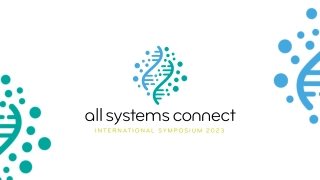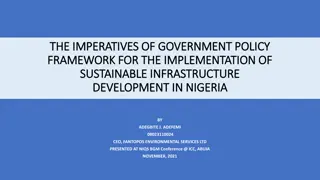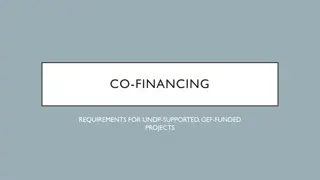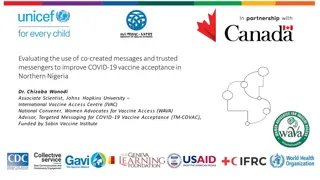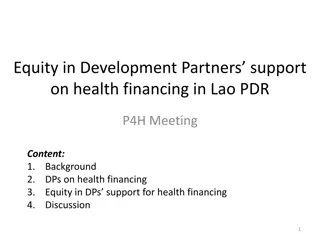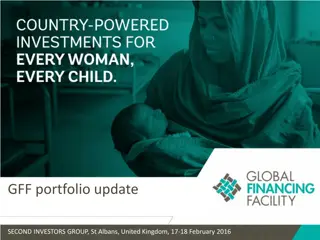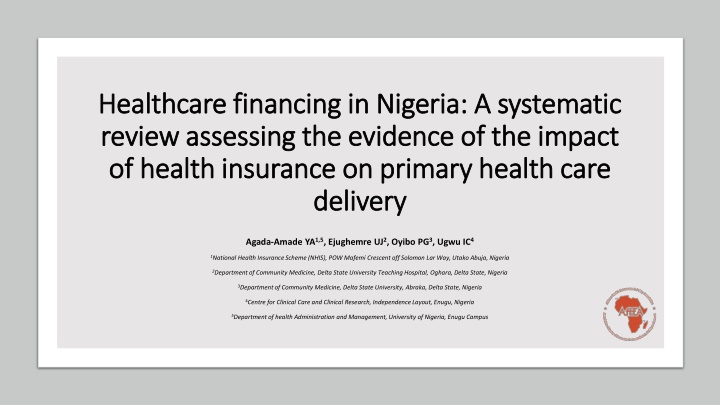
Impact of Health Insurance on Primary Healthcare Delivery in Nigeria
Explore the systematic review assessing the impact of health insurance on primary healthcare delivery in Nigeria, analyzing the evidence of its effectiveness in improving access and quality of care. The study focuses on the establishment and impact of pre-payment schemes within the National Health Insurance Scheme (NHIS) to enhance sustainable healthcare financing and achieve Universal Health Coverage (UHC).
Download Presentation

Please find below an Image/Link to download the presentation.
The content on the website is provided AS IS for your information and personal use only. It may not be sold, licensed, or shared on other websites without obtaining consent from the author. If you encounter any issues during the download, it is possible that the publisher has removed the file from their server.
You are allowed to download the files provided on this website for personal or commercial use, subject to the condition that they are used lawfully. All files are the property of their respective owners.
The content on the website is provided AS IS for your information and personal use only. It may not be sold, licensed, or shared on other websites without obtaining consent from the author.
E N D
Presentation Transcript
Healthcare financing in Nigeria: A systematic Healthcare financing in Nigeria: A systematic review assessing the evidence of the impact review assessing the evidence of the impact of health insurance on primary health care of health insurance on primary health care delivery delivery Agada-Amade YA1,5, Ejughemre UJ2, Oyibo PG3, Ugwu IC4 1National Health Insurance Scheme (NHIS), POW Mafemi Crescent off Solomon Lar Way, Utako Abuja, Nigeria 2Department of Community Medicine, Delta State University Teaching Hospital, Oghara, Delta State, Nigeria 3Department of Community Medicine, Delta State University, Abraka, Delta State, Nigeria 4Centre for Clinical Care and Clinical Research, Independence Layout, Enugu, Nigeria 5Department of health Administration and Management, University of Nigeria, Enugu Campus
Despite, the Alma Ata declaration, and the adoption of PHC (PHC) as the key strategy to achieve UHC, and the WHA 58.33 recommendation of adoption of prepayment method for healthcare to avoid catastrophic spending, sustainable health care financing in many low-resource countries such as Nigeria continues to be a problem. The Government of Nigeria established pre-payment schemes within the context of a NHIS These financing schemes were set-up to mobilize resources for healthcare and at the same time provide financial risk protection. It is important to periodically appraise the available empirical evidence of effect/impact of these reforms of Nigeria s healthcare financing to ensure that it achieves the objectives of sustainable health financing and UHC. Background Background
To review the effect of health insurance on access to PHC services in Nigeria and how it has affected the quality of care provided. Aim Aim
Methods 1/2 Methods 1/2 We conducted a review of published literatures reporting impact of HI on access to PHC and quality of care. We identified the research question. Two reviewers were assigned to searching, while two evaluated the titles and abstract of the articles. An articles is only accepted when agreed on by at least three reviewers Databases searched included Pubmed, Embase, Ovid and Google Scholar The search strategy The inclusion criteria include: The participants had to refer to Nigeria (in general). Participants include users of primary health services, where the reported mechanism of paying for health services was through HI The intervention (object of study) had to be a report of pre-payment schemes in PHC services (social, private and community health insurance);
Methods 2/2 Methods 2/2 Comparison: primary health services without any form of prepayment or health insurance; Outcome measures: changes in access to services, quality of care. Assessment of risk of bias Studies are non-randomized and extracted from articles and references. Assessment of risk of bias/quality appraisal was done for study design, selection bias, confounders, data collection methods, withdrawals, reports and analyses using a modified checklist for observational studies in epidemiology. Analysis Statistical pooling of outcome data (for meta-analysis) wasn t considered as the heterogeneity of the studies with regard to contextual and health services factors would have rendered such a meta-analysis potentially misleading. A narrative description of the results was conducted instead.
Flow chart of Flow chart of search results search results of studies from of studies from searching and searching and screening screening
Description of included studies Description of included studies Study settings All studies were conducted in Nigeria 2008 - 2013. two studies were conducted in communities in Northern Nigeria Six in communities in south eastern Nigeria One study in south western Nigeria. Non-randomized studies on HI Although, attempts to include them was made, no identified interventional study despite rigorous search methods applied. Of the nine studies included, 6 were cross-sectional, with one each used exploratory method, comparative case approach, review/appraisal and explanatory survey.
Study quality assessment protocol checklist of evidence (1) (2) (3) (4) (5) (6) (7) TOTAL RESEARCH/ ANALYTICAL QUESTION(S) RATIONALE METHODOLOGY DATA GOAL ACHIEVEMENT FINDINGS AND RESULTS DISCUSSION AND CONCLUSIONS Author (Ref), Year of Study Does the study have a clear and well-defined analytical/ research question? Does the study motivate its research question? (i) Does the study clearly describe the methods used to answer the analytical question(s)? (ii) Does the study make use of cross-sectional or time series statistical (descriptive/non- parametric) analysis, incl. significance levels in relevant sections? Sore 3 if study makes use of statistical regression analysis? (iii) Does the study use any kind of controls or alternative comparisons? (i) Is the type of information used in the study in terms of source, sample size, time period, levels etc. clearly described? (ii) Does the study make use of primary data for its key analyses? (iii) Does the study make use of household or provider level data? (i) Does the study answer (all of) the research/sub- question(s)? (i) Are all of the stated findings & results the outcome of the particular methods used in the current study? (ii) Are the results/findings credible with respect to method and data? (i) Does the study critically discuss the robustness of findings, potential sources of bias, and possible limitations of the approaches of choice? Mohammed Et Al.;2013 2 2 2 3 0 2 2 2 1 2 2 2 22 Iloh Et Al.,2012 2 2 2 1 0 2 2 2 1 2 2 1 19 Mohammed Et Al.;2011 Ibiyowe And Adeleke, 2008 Onwujekw Et Al., 2009 Onwujekwe Et Al.,2010 Onwujekwe Et Al.,2011 Adinma And Adinma,2011 2 2 2 3 1 2 2 2 2 2 2 2 24 2 2 2 3 0 1 2 2 2 2 2 2 22 2 2 2 3 1 2 2 2 2 2 2 2 24 2 2 2 1 1 2 2 2 2 1 2 2 21 2 2 2 1 2 2 2 2 2 1 2 1 21 1 1 1 0 0 1 1 1 2 1 1 1 11 Onoka Et Al., 2013. 2 2 1 0 0 2 1 2 2 1 2 1 16 Note. Source: Modified from Ekman B., 2004. Total points: Quality rating: Total points possible: 25 2 points are credited if the paper conforms fully to the question. 1 point is credited if the paper conforms partially to the question. 0 points are credited if the paper does not conform at all to the question. 3 points are credited if the paper uses statistical regressions analysis under question 3(iii), consequently precluding a score on 3(ii). Grading scale 22 25 points: 3 stars (***) 17 21 points: 2 stars (**) 0 16 points: 1 star (*)
Findings 1/3 Findings 1/3 The word access used to imply enrollees physically gaining entrance and utilizing (or consuming) health services. Studies reviewed used both descriptive statistics and regression analysis of data collected. Six studies used regression analysis of data collected to study the behavioral relationships (regarding stated preferences for CBHIs and satisfaction with the quality of care in SHI while the others used descriptive analysis. While studies on SHI surveyed respondents within and outside the health facilities, studies on CBHIs used household survey data as their principal source of information. The overall mean quality for the included studies was moderate (five studies received the high grade, one study was scored very low.
Findings 2/3 Findings 2/3 Access to care There is evidence of moderate-to-high strength in the literature suggesting that social and CBHIs have a positive effect on access to primary healthcare delivery. ANC and deliveries increased significantly following one year of commencement of a CBHIs in Anambra state, one of the states in eastern Nigeria; ANC (129, p < .05) and deliveries (41, p < .05). There was evidence of positive gain in accessing care at PHC in Enugu State The impact from a study in Ebonyi state is equivocal There was no such evidence from the literature on private health insurance. Almost all the studies revealed that insurance schemes enhanced financial access to quality care for primary health care needs in provider centres. Evidence from three studies by contingent valuation (stated preferences) showed that CBHIs will improve rural, periurban and urban enrollees access to primary health care services if it is thought that the benefit packages addresses the essential health needs in the communities.
Findings 3/3 Findings 3/3 Quality of care Four studies on SHI showed that HI improves the quality of care provided. One was equivocal Prompt attention, waiting time, availability of drugs and attitude of health workers to clienteles amongst others were said to be satisfactory by enrollees. Statistically significant relationships at p < .05 were shown. It was not clear whether CBHIs actually improved the quality of care in service units as the findings from three studies were inconclusive on this. One study on CBHIs showed better health outcomes for antenatal care and delivery amongst enrollees compared to non-enrollees. Challenges amongst the CBHIs is that the problem of vertical inequities between socioeconomic groups still occurred in CBHI schemes despite cross-subsidization. The exclusion effects are perceived to be due to limited pooling between groups and a negative trend in renewal rates. These problems continue to be of concern in spite of the willingness to pay for full coverage insurance in CBHIs particularly by the poorest.
Conclusion 1/2 Conclusion 1/2 The results of this review strongly suggests that the health sector reform in the country is making impacts. It is necessary that financing arrangements through HI be seen as a key strategy in achieving UHC in Nigeria. Some reviewed literatures: Nigeria needs to designs schemes that will expand coverage outside the formal sector. Heavy disease burden, burden of poverty, remote rural settings and variability in insurance provision across the country makes it a daunting task to achieve universal coverage through insurance schemes in the near future.
Conclusion 2/2 Conclusion 2/2 More advocacy, increased community participation, increased government and international developmental assistance is needed to improve current efforts and to achieve greater outcomes from the PHC system especially through HI schemes. Enrollees viewed cost of premiums and poor knowledge as barriers to membership. Evidence revealed the existence of regressive and inequitable contributions particularly in CBHIs due to the methods adopted by most of the schemes.
Thank you for Thank you for listening listening

